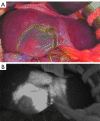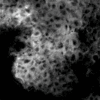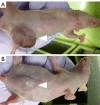Innovative treatment for hepatocellular carcinoma (HCC)
- PMID: 30505965
- PMCID: PMC6232072
- DOI: 10.21037/tgh.2018.10.04
Innovative treatment for hepatocellular carcinoma (HCC)
Abstract
Indocyanine green (ICG) is not new in the field of liver surgery. Early studies performed in the 1980s and 1990s revealed the value of the ICG clearance test in predicting post-hepatectomy morbidity and mortality. ICG clearance and retention tests are crucial for determining precise liver function before liver surgery and offer several benefits for safe surgery. Whereas ICG is well-known and has long history in medicine, recent progress in infrared light technology over the last decade has highlighted another feature of ICG. For example, ICG fluorescence-guided surgery may change the next generation of liver surgery. In the near future, ICG with near-infrared (NIR) light photodynamic therapy (PDT) is expected to become a new treatment method for hepatocellular carcinoma (HCC). Furthermore, several aspects of the mechanisms of ICG accumulation in HCC cells have been revealed by important basic research studies. New imaging technologies and mechanistic findings keep ICG in the spotlight. In this article, we review three recently described topics of ICG which may contribute to the development of innovative and new treatments method for HCC, fluorescence-guided surgery, mechanism of ICG accumulation in HCC cells, PDT for HCC.
Keywords: Indocyanine green (ICG); accumulation mechanism; fluorescence-guided surgery; near-infrared light (NIR light); photodynamic therapy (PDT).
Conflict of interest statement
Conflicts of Interest: The authors have no conflicts of interest to declare.
Figures







Similar articles
-
Near-infrared photothermal/photodynamic therapy with indocyanine green induces apoptosis of hepatocellular carcinoma cells through oxidative stress.Sci Rep. 2017 Oct 24;7(1):13958. doi: 10.1038/s41598-017-14401-0. Sci Rep. 2017. PMID: 29066756 Free PMC article.
-
Near-infrared fluorescence imaging and photodynamic therapy with indocyanine green lactosome has antineoplastic effects for hepatocellular carcinoma.PLoS One. 2017 Aug 31;12(8):e0183527. doi: 10.1371/journal.pone.0183527. eCollection 2017. PLoS One. 2017. PMID: 28859104 Free PMC article.
-
Indocyanine Green-Loaded Silver Nanoparticle@Polyaniline Core/Shell Theranostic Nanocomposites for Photoacoustic/Near-Infrared Fluorescence Imaging-Guided and Single-Light-Triggered Photothermal and Photodynamic Therapy.ACS Appl Mater Interfaces. 2016 Dec 28;8(51):34991-35003. doi: 10.1021/acsami.6b11262. Epub 2016 Dec 13. ACS Appl Mater Interfaces. 2016. PMID: 27957854
-
NIR fluorescence-guided tumor surgery: new strategies for the use of indocyanine green.Int J Nanomedicine. 2019 Sep 25;14:7823-7838. doi: 10.2147/IJN.S207486. eCollection 2019. Int J Nanomedicine. 2019. PMID: 31576126 Free PMC article. Review.
-
Use of Near-Infrared Fluorescence Techniques in Minimally Invasive Surgery for Colorectal Liver Metastases.J Clin Med. 2023 Aug 25;12(17):5536. doi: 10.3390/jcm12175536. J Clin Med. 2023. PMID: 37685603 Free PMC article. Review.
Cited by
-
Advances in the Genetically Engineered KillerRed for Photodynamic Therapy Applications.Int J Mol Sci. 2021 Sep 20;22(18):10130. doi: 10.3390/ijms221810130. Int J Mol Sci. 2021. PMID: 34576293 Free PMC article. Review.
-
The Role of ICG in Robot-Assisted Liver Resections.J Clin Med. 2022 Jun 19;11(12):3527. doi: 10.3390/jcm11123527. J Clin Med. 2022. PMID: 35743595 Free PMC article.
-
Photodynamic therapy: A next alternative treatment strategy for hepatocellular carcinoma?World J Gastrointest Surg. 2021 Dec 27;13(12):1523-1535. doi: 10.4240/wjgs.v13.i12.1523. World J Gastrointest Surg. 2021. PMID: 35070061 Free PMC article.
-
Recent Advances in Photodynamic Imaging and Therapy in Hepatobiliary Malignancies: Clinical and Experimental Aspects.Curr Oncol. 2021 Oct 11;28(5):4067-4079. doi: 10.3390/curroncol28050345. Curr Oncol. 2021. PMID: 34677263 Free PMC article. Review.
-
Nanotechnology strategies for hepatocellular carcinoma diagnosis and treatment.RSC Adv. 2022 Oct 31;12(48):31068-31082. doi: 10.1039/d2ra05127c. eCollection 2022 Oct 27. RSC Adv. 2022. PMID: 36349046 Free PMC article. Review.
References
Publication types
LinkOut - more resources
Full Text Sources
Miscellaneous
